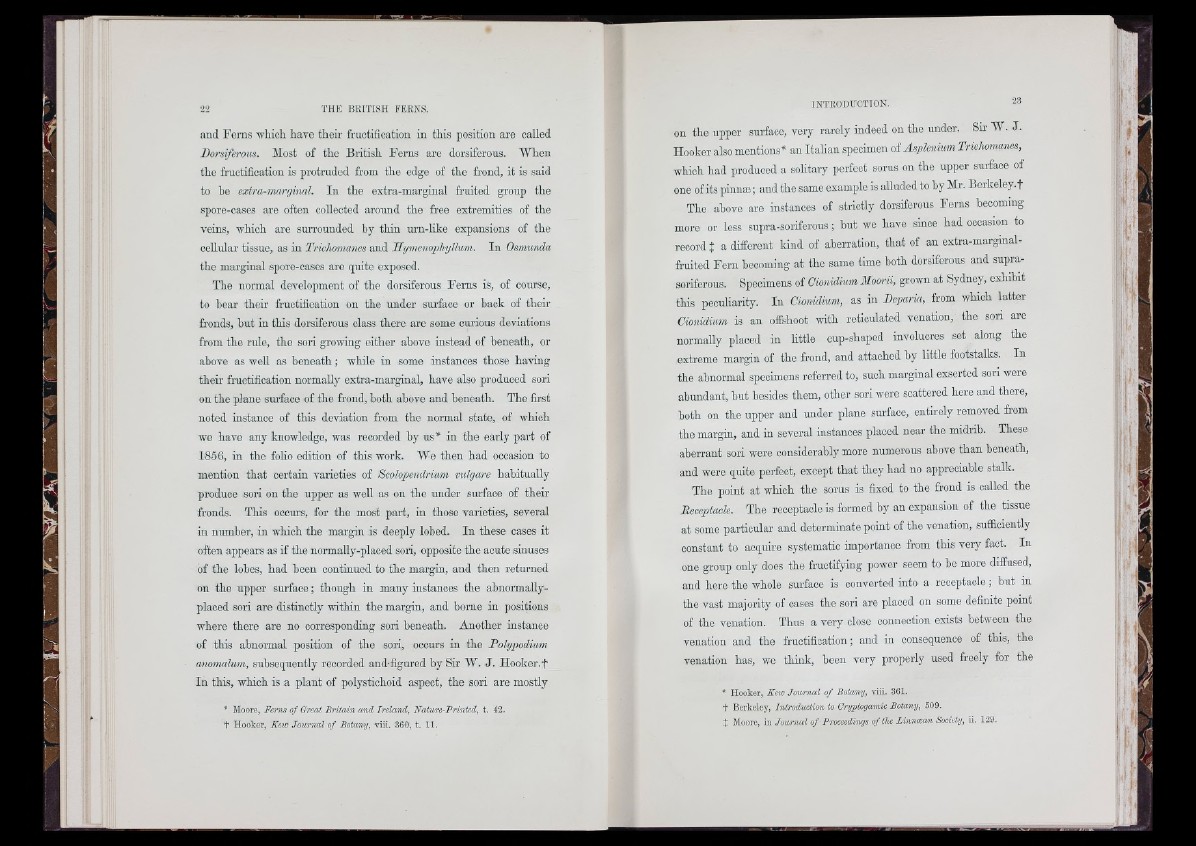
and Foms 'svliioli have their fructification in this position are called
Dorsiferous, Most of the British Ferns are dorsiferous. When
the fructification is protruded from tho edge of the frond, it is said
to be extra-marginal. In the extra-marginal fruited group the
spore-cases are often collected around the free extremities of the
veins, which are surrounded by thin urn-like expansions of the
cellular tissue, as in Trichomanes and llymenopliyllum. In Osmunda
the marginal spore-cases are quite exposed.
The normal development of tho dorsiferous Foms is, of course,
to bear thoir fmctification on the under surface or back of their
fronds, but in this dorsiferous class there are some curious deviations
from the rule, the sori growing either above instead of beneath, or
above as well as beneath; while in some instances those having
their fructification normally extra-marginal, have also produced sori
on the plane surface of the frond, both above and beneath. The first
noted instance of this deviation from the normal state, of which
we have any knowledge, was recorded by us* in the early part of
1866, in the folio edition of this work. Wc then had occasion to
mention that certain varieties of Scolopendrium mlgare habitually
produce sori on the upper as well as on the under surface of their
fronds. This occurs, for the most part, in those varieties, several
in number, in which the margin is deeply lobed. In these cases it
often appears as if the normally-placed sori, opposite the acute sinuses
of the lobes, had been continued to the margin, and then returned
on the upper surface; though in many instances the abnormally-
placed sori are distinctly within the margin, and borne in positions
where there are no corresponding sori beneath. Another instance
of this abnormal position of the sori, occurs in the Polypodium
anomalum, subsequently recorded and-figured by Sir W. J. Hooker.f
In this, which is a plant of polystichoid aspect, the sori are mostly
■* Moore, F cttis o f Great B r ita in and IrelaTid, Nature-Printed, t. 42,
t Hooker, Kew Journal o f Botany, viii. 360, t. 11.
on the upper surface, very rarely indeed on the under. Sir W. J.
Hooker also mentions* an Italian specimen of Asplénium Trichomanes,
which had produced a solitary perfect sorus on the upper surface of
one of its pinnæ ; and the same example is alluded to by Mr. Berkeley.!
The above are instances of strictly dorsiferous Ferns becoming
more or less supra-soriferous ; but we have since had occasion to
record! a different kind of aberration, that of an extra-marginal-
fruitod Fern becoming at the same time both dorsiferous and supra-
soriferous. Specimens of Oionidium Moorii, grown at Sydney, exhibit
this peculiarity. In Oionidium, as in Deparia, from which latter
Oionidium is an offshoot with reticulated venation, the sori are
normally placed in little cup-shaped involucres set along the
extreme margin of the frond, and attached by little footstalks. In
the abnormal specimens referred to, such marginal exserted sori were
abundant, but besides them, other sori were scattered here and there,
both on tho upper and under plane surface, entirely removed from
the margin, and in several instances placed near the midrib. These
aberrant sori were considerably more numerous above than beneath,
and were quite perfect, except that they had no appreciable stalk.
The point at which the sorus is fixed to the frond is called the
Receptacle. The receptacle is formed hy an expansion of the tissue
at some particular and determinate point of the venation, sufficiently
constant to acquire systematic importance from this very fact. In
one group only does the fructifying power seem to he more diffused,
and here the whole surface is converted into a receptacle ; but in
the vast majority of oases the sori are placed on some definite point
of the venation. Thus a very close connection exists between the
venation and tho fructification; and in consequence of this, the
venation has, we think, been very properly used freely for the
* Hooker, Kew Journal o f Botany, viii. 361.
+ Berkeley, Introduction to Cryptogamic Botany, 509.
i Moore, in Journal o f Proceedings o f the L in n x a n Society, ii. 129,